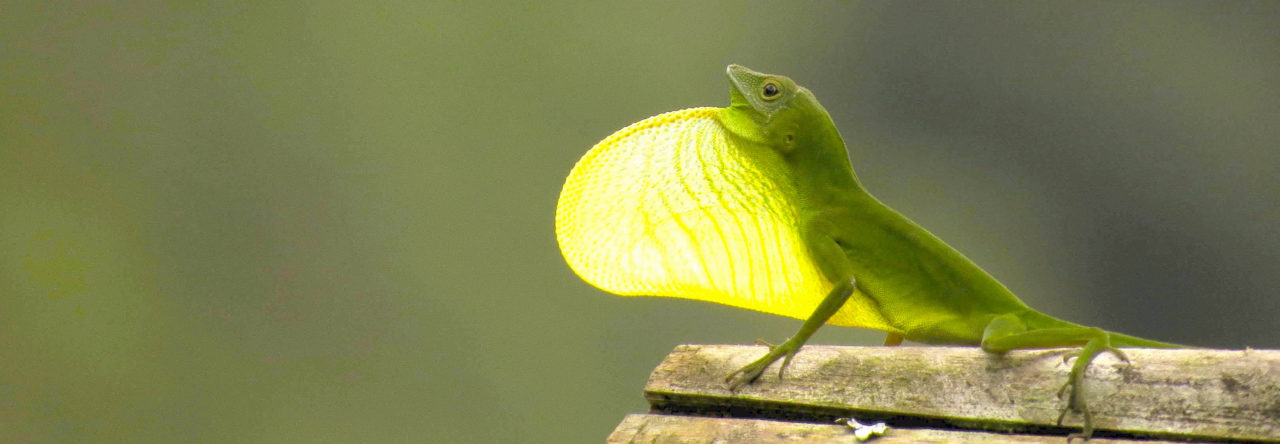“Among the strange and varied production of the high Andes is a small assemblage of grotesque, big-headed, short-legged, prehensile-tailed lizards: the genus Phenacosaurus.”
So starts Skip Lazell’s (1969) taxonomic revision of the three species in the anoline genus Phenacosaurus. Since that time, there have really been only two developments in phenac world. First, phylogenetic studies have conclusively demonstrated that phenacosaurs represent an evolutionary offshoot within the Dactyloa clade of anoles. As a result, most systematists now consider these species to be members of the genus Anolis, though some diehard romantics/heretics still use Phenacosaurus. Second, the last 40 years have seen a veritable phenaco-population explosion, with 11 species now recognized, and word on the street that more are on the way.
Despite these advances, our knowledge of phenacosaur biology has barely budged since Lazell’s time. Basically, there is only one paper in the literature on the field biology of these lizards, plus a smattering of information from species descriptions and taxonomic revisions. But before getting to that, a little bit of background: phenacosaurs are high elevation anoles (at least to 2600 m!), found in the Andes from Colombia to Peru. The quote above from Lazell captures the essence of their morphology, though I find them far from grotesque, and he doesn’t mention the large scales on their flanks and head.
More important, though, are their body dimensions: short-legged, short-tailed, slender, narrow head, these lizards scream out: Twig Anole! Morphometric analyses agree: these species are highly similar to Caribbean twig anoles, making them a potential exception to the generality that mainland anoles are not convergent on the Caribbean ecomorphs.
But there’s more than morphology to the ecomorph concept—members of an ecomorph class are convergent not only in morphology, but also in ecology and behavior. Do phenacosaurs live la vida ramita? The only detailed study of phenacosaur ecology, Ken Miyata’s five-day study of P. heterodermus in Colombia, suggests that they do. He found that 75% of the individuals he observed were on twigs and small branches. Behaviorally, they fit the bill, too, relying on crypsis and, from observations in captivity, relying on active searching to find prey, all hallmarks of twig anoles. Bits and pieces of observations from other papers are consistent with this view.
Still, there’s a lot more to learn about phenacosaurs: more detailed information on foraging in the wild, social interactions, display rates, activity patterns, especially of species other than P. heterodermus. For that reason, a group of us from Harvard, the Museum of Natural History in Paris and the Pontificia Universidad Católica del Ecuador is embarking today on a two-week trip to collect data on ecology, behavior, morphology, diet and other aspects of natural history biology of P. orcesi—a species whose natural history is completely unrecorded—in Ecuador. We’ll specifically be testing the hypothesis that this species’ natural history corresponds to that of West Indian twig anoles, and we’ll be gathering as much data as we can on the natural history of this and any other species we encounter.
A surprising conclusion one gets from reading the mini-literature on phenacosaurs is that they may be quite common, especially in bushes alongside roads and trails—Gorman et al. report finding three P. heterodermus in the first blackberry bush they examined! At first, this doesn’t square with the fact that there is so little published information on them, but, then, there are lots of mainland anoles about which we know little. Hopefully, we haven’t got our hopes set too high, but we’ll find out soon. More as the story develops!
- Third Mexican Amber Anolis Lizard Discovered - January 14, 2025
- Anolis Lizard Research Paves the Way for Advances in Treatment of Human Prostate Cancer - January 10, 2025
- When Two Lizards Meet for the First Time, Scientists Witness Evolution in Action - January 3, 2025




hispanioland
They look pretty much like the caribbean ” Xiphocercus”… Got to see and photograph A. darlingtoni, and the resemblance in morphology is obvious: elongated head, short limbs, prehensile tail (thicker than I expected) and rounded and relatively big lateral/mid-body scales (also large head scales). Also in pattern and coloration, they have that banded pattern across the body, in a monochromatic coloration, and with a dark dosrum, white throat and venter. Althought no behavioral observations were obtained, with all stated, I bet they are convergent.